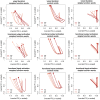Understanding the Phonetic Characteristics of Speech Under Uncertainty-Implications of the Representation of Linguistic Knowledge in Learning and Processing
- PMID: 35548492
- PMCID: PMC9083257
- DOI: 10.3389/fpsyg.2022.754395
Understanding the Phonetic Characteristics of Speech Under Uncertainty-Implications of the Representation of Linguistic Knowledge in Learning and Processing
Abstract
The uncertainty associated with paradigmatic families has been shown to correlate with their phonetic characteristics in speech, suggesting that representations of complex sublexical relations between words are part of speaker knowledge. To better understand this, recent studies have used two-layer neural network models to examine the way paradigmatic uncertainty emerges in learning. However, to date this work has largely ignored the way choices about the representation of inflectional and grammatical functions (IFS) in models strongly influence what they subsequently learn. To explore the consequences of this, we investigate how representations of IFS in the input-output structures of learning models affect the capacity of uncertainty estimates derived from them to account for phonetic variability in speech. Specifically, we examine whether IFS are best represented as outputs to neural networks (as in previous studies) or as inputs by building models that embody both choices and examining their capacity to account for uncertainty effects in the formant trajectories of word final [ɐ], which in German discriminates around sixty different IFS. Overall, we find that formants are enhanced as the uncertainty associated with IFS decreases. This result dovetails with a growing number of studies of morphological and inflectional families that have shown that enhancement is associated with lower uncertainty in context. Importantly, we also find that in models where IFS serve as inputs-as our theoretical analysis suggests they ought to-its uncertainty measures provide better fits to the empirical variance observed in [ɐ] formants than models where IFS serve as outputs. This supports our suggestion that IFS serve as cognitive cues during speech production, and should be treated as such in modeling. It is also consistent with the idea that when IFS serve as inputs to a learning network. This maintains the distinction between those parts of the network that represent message and those that represent signal. We conclude by describing how maintaining a "signal-message-uncertainty distinction" can allow us to reconcile a range of apparently contradictory findings about the relationship between articulation and uncertainty in context.
Keywords: context; cue-to-outcome structure; discriminative learning; enhancement; linguistic knowledge; morphological structure; phonetic characteristics; reduction.
Copyright © 2022 Tomaschek and Ramscar.
Conflict of interest statement
The authors declare that the research was conducted in the absence of any commercial or financial relationships that could be construed as a potential conflict of interest.
Figures



Similar articles
-
CiwGAN and fiwGAN: Encoding information in acoustic data to model lexical learning with Generative Adversarial Networks.Neural Netw. 2021 Jul;139:305-325. doi: 10.1016/j.neunet.2021.03.017. Epub 2021 Mar 19. Neural Netw. 2021. PMID: 33873122
-
Attention Differentially Affects Acoustic and Phonetic Feature Encoding in a Multispeaker Environment.J Neurosci. 2022 Jan 26;42(4):682-691. doi: 10.1523/JNEUROSCI.1455-20.2021. Epub 2021 Dec 10. J Neurosci. 2022. PMID: 34893546 Free PMC article.
-
Learning words' sounds before learning how words sound: 9-month-olds use distinct objects as cues to categorize speech information.Cognition. 2009 Nov;113(2):234-43. doi: 10.1016/j.cognition.2009.08.010. Epub 2009 Sep 17. Cognition. 2009. PMID: 19765698
-
When theories of speech meet the real world.J Psycholinguist Res. 1998 Mar;27(2):111-22. doi: 10.1023/a:1023289713883. J Psycholinguist Res. 1998. PMID: 9561782 Review.
-
Morphological errors and the representation of morphology in the lexical-semantic system.Philos Trans R Soc Lond B Biol Sci. 1994 Oct 29;346(1315):79-87. doi: 10.1098/rstb.1994.0131. Philos Trans R Soc Lond B Biol Sci. 1994. PMID: 7886157 Review.
References
-
- Arnold D., Tomaschek F. (2016). “The Karl Eberhards Corpus of spontaneously spoken Southern German in dialogues - audio and articulatory recordings,” in Tagungsband der 12. Tagung Phonetik und Phonologie im deutschsprachigen Raum, eds C. Draxler and F. Kleber (München: Ludwig-Maximilians-Universität München; ), 9–11.
-
- Arppe A., Hendrix P., Milin P., Baayen R. H., Sering T., Shaoul C. (2018). ndl: Naive Discriminative Learning. Available online at: https://CRAN.R-project.org/package=ndl
LinkOut - more resources
Full Text Sources

